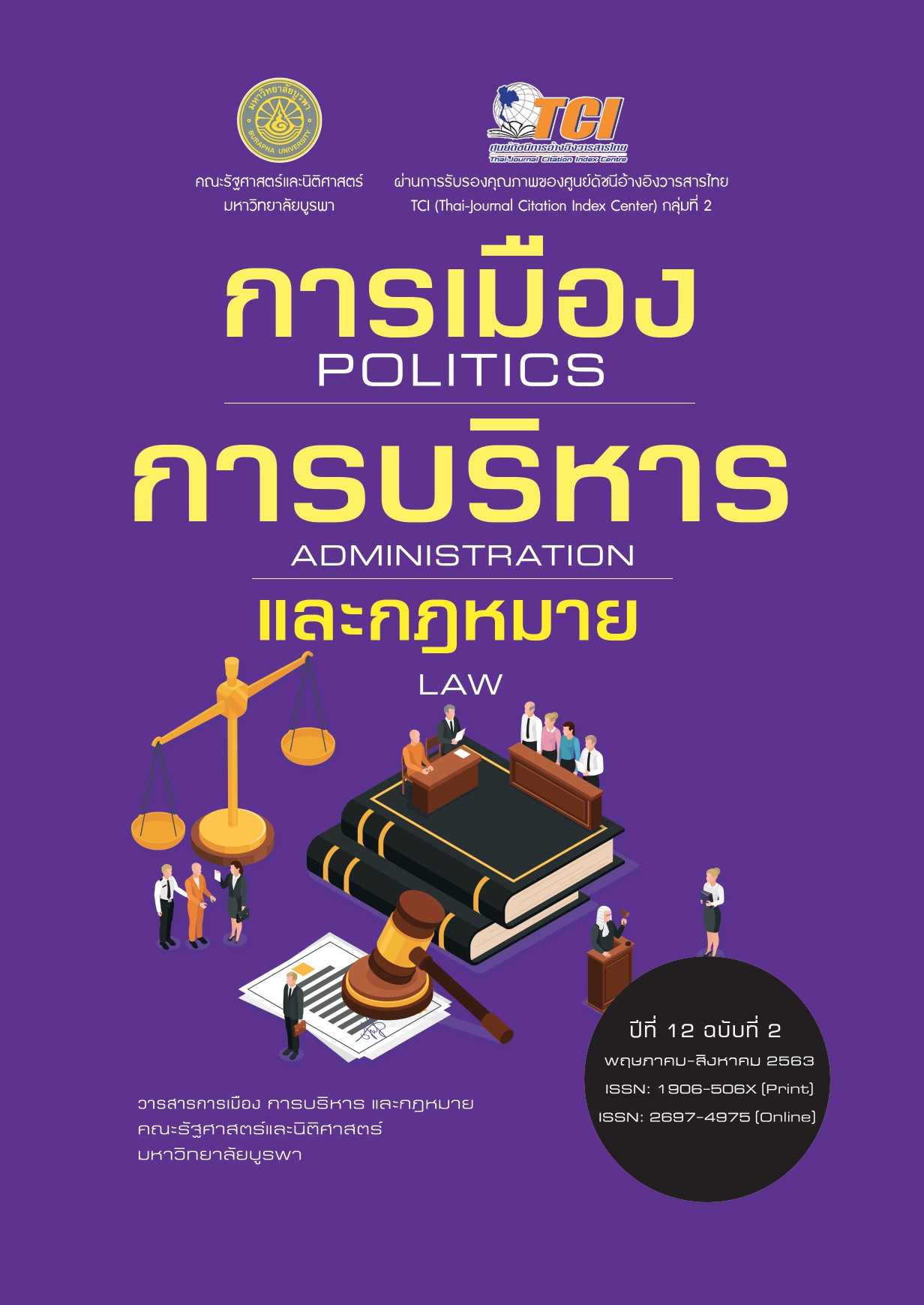Measures of Prevention and Solution of Fraud Problems in Thailand’s Agricultural Cooperatives
Keywords:
Agricultural cooperatives, Fraud problems, Measures of prevention and solution of fraud problemsAbstract
The main objective of this study was to propose the measures in preventing and solving fraud problems of agricultural cooperatives in Thailand by using mixed methodology. The study started with the qualitative research conducted by using in-depth interviews with key informants to find the causes of problem conditions and ways of preventing and solving fraud problems of agricultural cooperatives in Thailand. Data analysis was performed by using the content analysis. Subsequently, the results of the content analysis were used as a guideline for creating questionnaires for the quantitative research. Data were collected from 416 samples of cooperative inspectors, public cooperative auditors and the president of cooperative member group, by using the Yamane formula (Yamane, 1973). The errors were determined to be of 5 percent. The stratified random sampling was performed by using the provinces and the samples group as the criteria in the classification for the Exploratory Factor Analysis (EFA) It was found from the results of the study that there were 4 key preventive measures against problems that were found in Thailand’s agricultural cooperatives, which included 1) the measure in building and developing an effective promoting, supporting and supervising system for the cooperatives, 2) the measure in creating efficient system for the supervision and internal audit of cooperatives, 3) the measure in specifying the policies, laws, regulations, and ethics for transparent operations; and 4) the measure in boosting cooperation among the cooperative movements to prevent fraud from happening. Aside from these, there were 2 main measures in solving the problem of fraud in the agricultural cooperatives in Thailand as follows: 1) the measure in dealing with offenders under the strict legal procedures; and 2) the measure in remedying the victims and relieving the severity of fraud problems. However, the concerned parties could also apply this for the policy making and could establish a system or develop an effective supervising system for agricultural cooperatives further.
References
คณะกรรมาธิการวิสามัญขับเคลื่อนการปฏิรูปประเทศ ด้านการป้องกันปราบปรามการทุจริตและประพฤติมิชอบ. (2558). การปฏิรูปมาตรการเสริมสร้างระบบการบริหารงานที่มีธรรมาภิบาลในภาครัฐ. วันที่ค้นข้อมูล 20 พฤศจิกายน 2560, เข้าถึงได้จากhttps://libraparliament.go.th/giventake/content_nrsa2558/d091959-01.pdf
จุฑารัตน์ เอื้ออำนวย. (2551). สังคมวิทยาอาชญากรรม. กรุงเทพ: บริษัท วีพริ้นท์ (1991) จำกัด.
เดือนเด่น นิคมบริรักษ์ และคณะ. (2554). ปัญหาการทุจริตคอร์รัปชั่นในวงการธุรกิจเอกชนไทยกับแนวทางแก้ไขและป้องกัน. กรุงเทพฯ: มูลนิธิสถาบันวิจัยเพื่อการพัฒนาประเทศไทย.
ประวีณา ชะลุย. (2549). การนำเสนอยุทธศาสตร์การศึกษาเพื่อพัฒนากระบวนการชุมชนในการป้องกันการทุจริต. กรุงเทพฯ: จุฬาลงกรณ์มหาวิทยาลัย
พรชัย ขันตี, (2553). ทฤษฎีอาชญาวิทยา: หลักการงานวิจัยและนโยบายประยุกต์. กรุงเทพฯ: สุเนตรฟิล์ม.
รุจิพัชร์ กิตติวิวัฒนพงศ์ และกนกรัตน์ ยศไกร. (2559). ความย้อนแย้งของสหกรณ์ออมทรัพย์ดีเด่นในประเทศไทยกับปัญหาคอร์รัปชัน. วารสารวิชาการมหาวิทยาลัยอีสเทิร์นเอเชีย ฉบับสังคมศาสตร์และมนุษย์ศาสตร์, 6(1), 235.
ศิลาพร ไชสวัสดิ์ และ ญาดา กาศยปนันทน์. (2559). มาตรการทางกฎหมายเกี่ยวกับการป้องกันและปราบปรามผู้บริหารสหกรณ์ยักยอกทรัพย์และฉ้อโกง. ม.ป.ท.
สิริพันธ์ พลรบ. (2555). หลักความเป็นธรรมทางกฎหมายและกฎหมายทรัสต์ (หน่วยที่ 4). เอกสารประกอบการสอน มหาวิทยาลัยสุโขทัยธรรมาธิราช.
สุดสงวน สุธีสร. (2543). เหยื่ออาชญากรรม. กรุงเทพฯ: พิมพ์ดี.
สุดสงวน สุธีสร. (2554). อาชญาวิทยา. กรุงเทพฯ: สำนักพิมพ์มหาวิทยาลัยธรรมศาสตร์.
สำนักงานเศรษฐกิจการคลัง. (2560). การศึกษาหลักเกณฑ์สากลและกฎหมายต่างประเทศที่เกี่ยวกับการกากับดูแลสหกรณ์เพื่อการพัฒนากฎหมายสหกรณ์ของไทย. วันที่ค้นข้อมูล 22 ธันวาคม 2560, เข้าถึงได้จาก http://www.fpo.go.th/eresearch/getattachment/2201a7b8-6675-4d26-8e5a-b1af9fb4debc/9112.aspx
อุษณา ภัทรมนตรี. (2558). การตรวจสอบภายในสมัยใหม่ (ฉบับปรับปรุงและพิมพ์ครั้งที่ 5). กรุงเทพฯ: โรงพิมพ์จามจุรีโปรดักท์.
Berle, A., & Means, G. (1932). The Modern Corporation and Private Property. New York: Macmillan Co.
Coleman, J. W. (2006). The Criminal Elite Understanding White Collar Crime. New York: Worth Publishers.
Cressey, D. R. (1996). Insider Trading: Regulation Enforcement and Prevention. Clark Boardman: Callaghan.
Global Fraud Report. (2010). Retrieved January 21, 2019, from https://eiuperspectives.economist. com/strategy- leadership/global-fraud-report-2009-2010
Sutherland, E. H. (1961). The Nature Impact and Persecution of White-Collar-Crime. White Collar Crime. N.Y. Holt, rineheart and Winton.
Hair, J. F., Black, W. C., & Babin, B. J. (2010). Multivariate Data Analysis A Global Perspective: Pearson Education. New Jersey: U.S.A.
Yamane, T. (1973). Statistics: An Introductory Analysis (3rd ed.). New York: Harper






